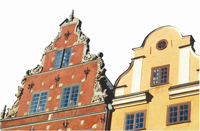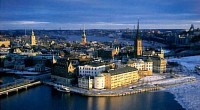Receive our newsletter
Your e-mail address is only used to send you our newsletter and information about the activities of Strasbourg Europe. You can always use the unsubscribe link included in the newsletter.

 Sweden’s capital, Stockholm, is partly built on an archipelago in the Baltic Sea, composed of 24,000 islands. The old town, which has retained its narrow streets and medieval houses, is located on Staden mellan Broarna island. Nicknamed the “city between the bridges”, this island was the first to be inhabited among the 14 islands now covered by the capital. A major industrial port, Stockholm is also a leading cultural center. It is home to many museums, including the Skansen museum, the world’s leading open-air museum, which includes reconstructed traditional Swedish houses. The town also boasts a large number of monuments, including the royal palace, the Storkyrkan cathedral where the Swedish kings were crowned, and the modern city hall where the Nobel prizes are awarded. Stockholm became the European Capital of Culture for 1998.
Sweden’s capital, Stockholm, is partly built on an archipelago in the Baltic Sea, composed of 24,000 islands. The old town, which has retained its narrow streets and medieval houses, is located on Staden mellan Broarna island. Nicknamed the “city between the bridges”, this island was the first to be inhabited among the 14 islands now covered by the capital. A major industrial port, Stockholm is also a leading cultural center. It is home to many museums, including the Skansen museum, the world’s leading open-air museum, which includes reconstructed traditional Swedish houses. The town also boasts a large number of monuments, including the royal palace, the Storkyrkan cathedral where the Swedish kings were crowned, and the modern city hall where the Nobel prizes are awarded. Stockholm became the European Capital of Culture for 1998.
 Alfred Nobel was born in Stockholm in 1833. He devoted his life to science at an early age, and in 1867 he obtained a patent for the invention of dynamite, a powerful explosive made from nitro-glycerine and clay. This invention was by far his most important, but it is easy to forget that more than 350 patents were lodged by the famous Swedish chemist throughout his career. When he died in 1896, Alfred Nobel left practically nothing to his direct heirs. In accordance with his last wishes, his heritage was used to create a foundation given the task of rewarding people who have served the various causes of humanity. Each year on December 10th (the anniversary of Nobel’s death), Nobel Prizes are awarded in five different categories, these being physics, chemistry, medicine or physiology, literature and peace. Originally worth 150,000 krona in 1901, the Nobel Prize has been increased regularly. In 2003 it stood at 10 million Swedish krona (approximately €1.1 million)
Alfred Nobel was born in Stockholm in 1833. He devoted his life to science at an early age, and in 1867 he obtained a patent for the invention of dynamite, a powerful explosive made from nitro-glycerine and clay. This invention was by far his most important, but it is easy to forget that more than 350 patents were lodged by the famous Swedish chemist throughout his career. When he died in 1896, Alfred Nobel left practically nothing to his direct heirs. In accordance with his last wishes, his heritage was used to create a foundation given the task of rewarding people who have served the various causes of humanity. Each year on December 10th (the anniversary of Nobel’s death), Nobel Prizes are awarded in five different categories, these being physics, chemistry, medicine or physiology, literature and peace. Originally worth 150,000 krona in 1901, the Nobel Prize has been increased regularly. In 2003 it stood at 10 million Swedish krona (approximately €1.1 million)
Alfred Nobel © www.imagebank.sweden.se
 Every year during December,Sweden celebrates the “Saint Lucia celebration”. The legend of Lucia, the holy martyr of Syracuse, probably dates back to the 4th century. According to the legend, Lucia had helped Christians persecuted by the Romans to survive by bringing them food in their hiding places. To light her way, she wore a crown of candles on her head. Having betrayed the Romans, she was condemned to be burned alive, but as the flames could not harm her, she was finally killed with a sword on December 13, 304. The date of this celebration, which was introduced in Sweden during the 19th century, also has another meaning for the Swedes. According to the Julian calendar (the calendar used in Europe until 1582), this is also the shortest day and therefore theoretically the darkest day of the year. Consequently, it can be said that the Swedes are actually celebrating the return of the light and the origin of the word: “Lucia” comes from the Latin word “lux” which means light. In Sweden, the day of Saint Lucia is celebrated throughout the country. Dressed in white, with a crown of candles on her head, the Lady of Light brings saffron buns (“lussekatter”) and light to each Swedish home.
Every year during December,Sweden celebrates the “Saint Lucia celebration”. The legend of Lucia, the holy martyr of Syracuse, probably dates back to the 4th century. According to the legend, Lucia had helped Christians persecuted by the Romans to survive by bringing them food in their hiding places. To light her way, she wore a crown of candles on her head. Having betrayed the Romans, she was condemned to be burned alive, but as the flames could not harm her, she was finally killed with a sword on December 13, 304. The date of this celebration, which was introduced in Sweden during the 19th century, also has another meaning for the Swedes. According to the Julian calendar (the calendar used in Europe until 1582), this is also the shortest day and therefore theoretically the darkest day of the year. Consequently, it can be said that the Swedes are actually celebrating the return of the light and the origin of the word: “Lucia” comes from the Latin word “lux” which means light. In Sweden, the day of Saint Lucia is celebrated throughout the country. Dressed in white, with a crown of candles on her head, the Lady of Light brings saffron buns (“lussekatter”) and light to each Swedish home.
 If there is one raw material they don’t lack in Sweden, it’s wood! More than half of the country’s surface area is covered by forests. As a result, the wood industry plays an important role here. Sweden produces paper and wood pulp, but above all furniture. Today, IKEA is the world’s leading furniture manufacturer.
If there is one raw material they don’t lack in Sweden, it’s wood! More than half of the country’s surface area is covered by forests. As a result, the wood industry plays an important role here. Sweden produces paper and wood pulp, but above all furniture. Today, IKEA is the world’s leading furniture manufacturer.Your e-mail address is only used to send you our newsletter and information about the activities of Strasbourg Europe. You can always use the unsubscribe link included in the newsletter.
Information Center
on the European Institutions (CIIE)
Europe Direct Information Center
All rights reserved to the CIIE
Non-profit organization
Mailing address
1 allée Kastner
67000 Strasbourg
France
Visitors entrance
8 rue Boecklin
67000 Strasbourg
France
To provide the best experiences, we use technologies such as cookies to store and/or access device information. Consenting to these technologies will allow us to process data such as browsing behavior or unique IDs on this site. Failure to consent or withdrawing consent may adversely affect certain features and functions.